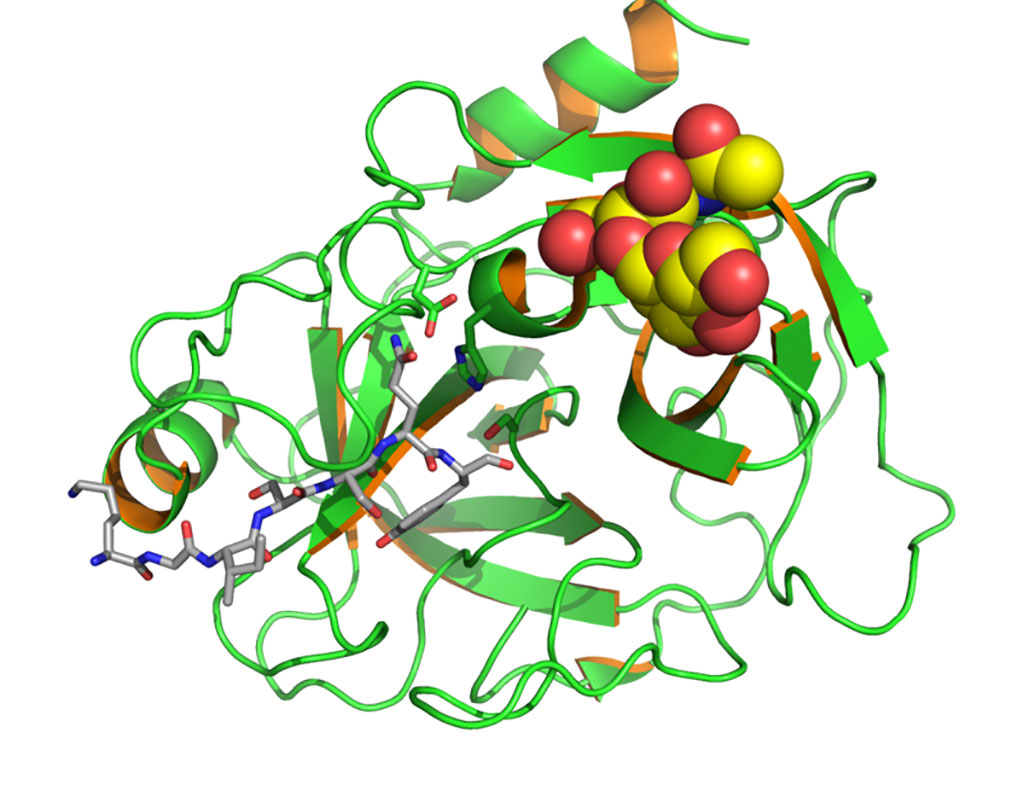A Novel Lateral Flow Immunoassay System for Determination of Prostate Specific Antigen
By LabMedica International staff writers
Posted on 10 Jan 2022
A recent paper described the development of a highly portable quantitative screening test for prostate cancer.Posted on 10 Jan 2022
Prostate cancer (PCa) is the second most diagnosed cancer among men. Prostate-specific antigen (PSA) is the most reliable and widely accepted tumor biomarker for screening and monitoring of PCa status. PSA is present in small quantities in the serum of men with healthy prostates, but is often elevated in the presence of prostate cancer or other prostate disorders. It is a 34,000 Dalton glycoprotein produced almost exclusively by the prostate gland. PSA is a serine protease enzyme, the gene of which is located on the 19th chromosome.

Image: Human prostate specific antigen (PSA) with bound substrate from complex with antibody (Photo courtesy of Wikimedia Commons)
Since quantification of serum PSA requires access to centralized laboratories, which may not be available in developing countries, investigators at Cornell University (Ithaca, NY, USA) developed a rapid test system including a highly portable strip reader for off-site quantification of total PSA from a drop of serum within 20 minutes.
The system was based on the lateral flow immunoassay (LFIA) method. LFIA-based tests have been coupled with smartphones and battery powered portable readers for imaging the test strips at the point of care. Lateral flow test strips rely on capillary flow within a nitrocellulose membrane without need for external pump or moving components to control the flow. However, at present, [U.S.] FDA approved LFIA for PSA is not commercially available.
The most common nanoparticles used in commercial LFIAs are 40 nanometer gold nanospheres due to their optimal combination of high contrast color (absorption at about 523 nanometers) with distinct cherry red color for visual readouts and surface area suitable for targeting analytes of a wide range of sizes. In the current study, the investigators compared the performance of gold nanoshells with the widely used, industry standard 40 nanometer gold nanospheres.
The structure of gold nanoshells consists of 110 nanometer core silica spheres with a thin (12–18 nanometer) gold shell deposited over them. The silica core reduces the overall particle density relative to a solid gold nanosphere of same size, allowing for improved flow rates through a lateral flow membrane compared to a 150 nanometer solid gold sphere. Gold nanoshells produce a high contrast blue-grey line that is clearly visible.
The investigators first optimized and evaluated the performance of the assay with commercially available total PSA calibrators. On initial validation with a commercially available PSA calibrator, a detection range of 0.5–150 nanograms/milliLiter was achieved. They then compared the performance of the total PSA LFIA test with the Siemens-Healthineers (Erlangen, Germany) IMMULITE analyzer for quantification of total PSA in archived human serum samples.
Results revealed that the use of gold nanoshells as a label for the lateral flow assay increased the measured colorimetric signal intensity and achieved a five times lower detection limit when compared to the traditionally used 40 nanometer gold nanosphere labels. This increased sensitivity yielded results for archived serum samples that demonstrated greater than 0.95 correlation between the rapid LFIA test and the IMMULITE analyzer.
“We will be able to take a drop of blood in a community setting such as a barbershop and be able to deliver results in 10 to 15 minutes right there, which can indicate when somebody needs to come in for further tests,” said senior author Dr. Saurabh Mehta, professor of nutritional sciences at Cornell University. “It is creating that first point of contact that hopefully builds rapport and brings health care services to the people at the point of need,”
The rapid LFIA for measurement of PSA was described in the November 14, 2021, online edition of the journal Current Research in Biotechnology.
Related Links:
Cornell University
Siemens-Healthineers













